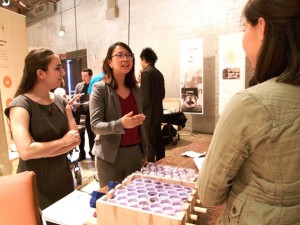View Source | May 26, 2015
 Much like the plot of a superhero-team comic, many of today’s greatest challenges can only be overcome when the unique strengths of the resolute are combined.
Much like the plot of a superhero-team comic, many of today’s greatest challenges can only be overcome when the unique strengths of the resolute are combined.
Arizona State University’s InnovationSpace®, a yearlong product-design and -development program intent on tackling societal challenges, recognizes this.
That’s why the program – initially a venture among ASU’s Herberger Institute for Design and the Arts, W. P. Carey School of Business and Ira A. Fulton Schools of Engineering – opted to diversify its disciplinary profile even further by including the School of Sustainability this past academic year.
The expertise of InnovationSpace faculty ranges from marketing to biomimicry, and each instructor takes a turn lecturing and leading learning activities in an advanced integrated process. As a result, students transform dry-erase board sketches into environmentally conscious, economically viable and life-changing prototypes by the program’s conclusion.
Rubing Qiang, a W. P. Carey School of Business senior studying both supply-chain management and marketing, belonged to one of three teams focused on mobility enhancements for individuals who use wheelchairs.
Qiang and her teammates developed Novo, an air bladder, foam-fusion seat lined with sensors to decrease the likelihood of pressure sores – an ailment all-too-familiar to wheelchair users. The seat connects to an app that indicates high-pressure areas, suggests settings for optimal comfort, and includes features such as interactive games and a monitoring system for doctors.
“InnovationSpace provided me with a great platform to meet students and faculty from multiple disciplines, and work with them toward the same goal,” Qiang said. “I learned to look at problems from various perspectives with the help of my group mates, who are from other majors. Collaboration through interdependence is one of the most precious experiences I gained from this program.”
Because sustainable solutions are inherently transdisciplinary, the diversity of fields among InnovationSpace students mirrors that of the faculty. This year, each team of five included a student from industrial design, visual communication design, engineering, business and sustainability.
Hayley Cook is pursuing a sustainability degree in the energy, materials and technology track, as well as a minor in anthropology. She and her teammates developed a power wheelchair controller called Cygnal, which features a touch screen and makes user navigation both simpler and more comfortable.
Upon completing the InnovationSpace program, Cook feels she has a more thorough understanding of sustainability – as an idea and as a practice.
“I’ve loved working with students in other disciplines to manifest my ideas in a practical way – not only to create innovative products, but also to teach others how to incorporate sustainability into their fields,” she said. “And, ultimately, we developed a better solution than any of us could have produced on our own.”
The financial resources to fashion such prototypes have been supplied by companies such as the Intel Corporation, Herman Miller Inc., Procter & Gamble, and Disney Consumer Products in the past. This year, InnovationSpace was made possible in part by the Ray C. Anderson Foundation, which continues the work of sustainability champion and visionary Ray Anderson.
Anderson served on the Board of Directors for Sustainability at ASU, and his foundation has funded other prominent ventures like ASU’s iProjects – a collaboration between the School of Sustainability and College of Technology and Innovation.
“Ray Anderson made the advancement of sustainable production and consumption systems his personal mission,” said Christopher Boone, an InnovationSpace instructor and the School of Sustainability’s dean. “He was a pioneer in this field, and InnovationSpace is a testament to his enduring legacy.”
The legacy extends well beyond InnovationSpace walls, as some teams pursue patents for – and form business ventures around – their sustainable-product solutions. In the past, several teams that developed assistive technologies and health-care products received funding from the Edson Student Entrepreneurship Initiative.
“The integrated product-development process allows students to make a transformative impact without sacrificing any of their core principles,” said Prasad Boradkar, a senior sustainability scientist and the director of InnovationSpace. “When they leave this program, they are armed with the tools, techniques and knowledge they need to change the world."
Kayla Bellman is pursuing degrees in sustainability and global studies, as well as a certificate in human rights. Her group, Team Noodle, was among three to tackle the common lack of creativity and collaboration in the workplace. Team Noodle’s reimagined conference table promotes “serious play” through features like the “idea puck,” an air-hockey-like brainstorming exercise.
“If you are interested in working across multiple disciplines, gaining insight into the design process, exercising your creative juices and having tangible deliverables to show potential employers,” Bellman said, “I urge you to apply for the 2015-16 InnovationSpace program.”
The experiences of Qiang, Cook, Bellman and their classmates not only highlight the enriching quality of collaboration, but demonstrate that when disciplines combine, no challenge is too great for innovation.

